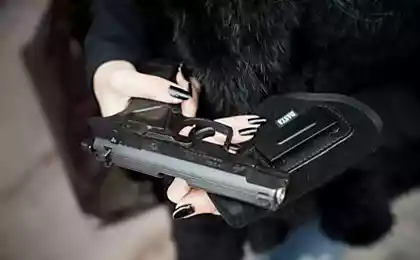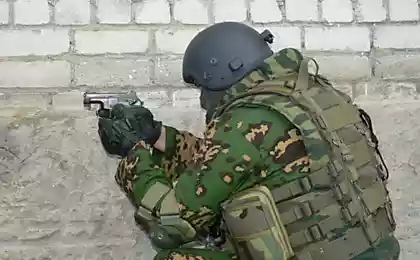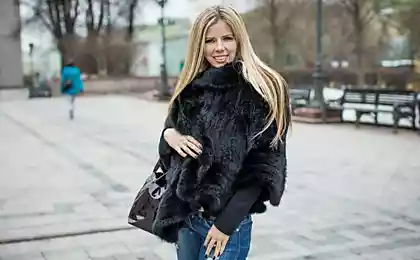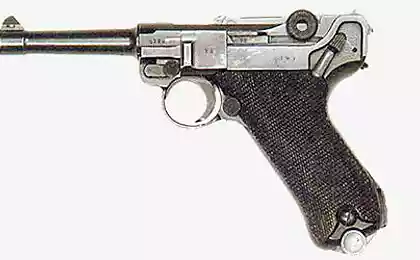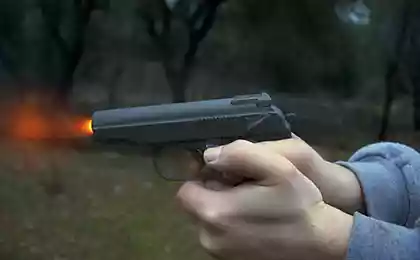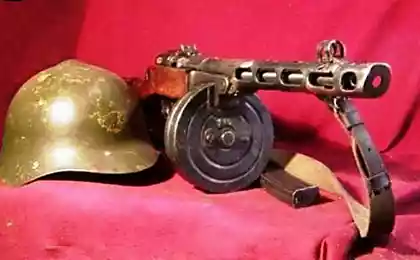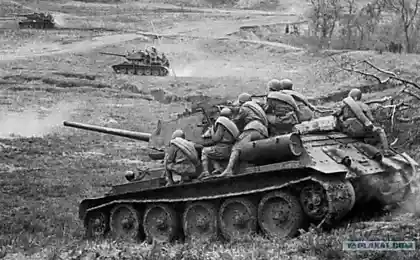1098
A little-known weapon of the Second World
During the Second World War it was invented and applied plenty of new weapons, some of which are still very well known. But there was also a weapon that will not find its glory. Below is the weapon, which you most likely have not heard.
Advance reservation that all the weapons listed below, was used during the war. Although there was plenty of high-tech (and sometimes quite strange) development, here we go just about something interesting weapon, which was actually used.
V-3

V-1, V-2 and V-3 (V-3 is also known as "Centipede" and "The English cannon") - a project of the Nazis under the name "Revenge Weapon". V-3 - an enormous cannon, built on a hill and is capable of being in France, to bombard London across the English Channel. The gun had a total length of 124 m, a gun barrel 32 consists of four long sections, 48 m; Each section had two located along the trunk at an angle to it bolt. During the trial in May 1944 showed a gun firing range of 88 kilometers, and during testing in July 1944 flight of the projectile was 93 kilometers.
It was built two guns V-3, and only one of them has been applied in practice. From 11 January to 22 February 1945 it produced about 183 shots. The aim was recently freed from Nazi Luxembourg. But the gun only to demonstrate their inefficiency. Objectives reached 143 shells, which, fortunately, was killed just 10 people and 35 were injured.
Super-heavy railway artillery "Dora" and "Gustav»
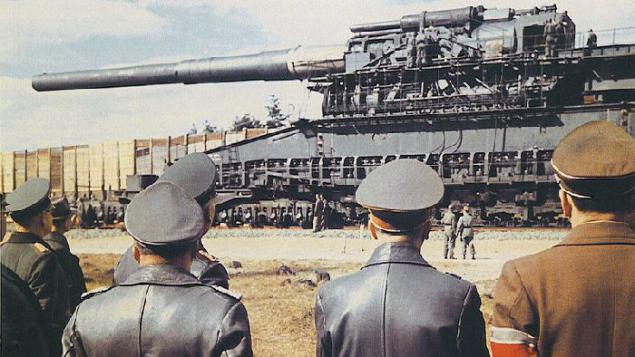
The Nazis was definitely a "quirk" about the big guns. These two guns caliber 807 mm were just gigantic. Indeed, it was the largest in the world gun. Each of them could only be transported in parts, then they should be collected and placed on pre-prepared platform - for all these procedures took about 4,000 people. The Nazis launched a full regiment of anti-aircraft guns for protection, and special forces protected them from the guerrillas.
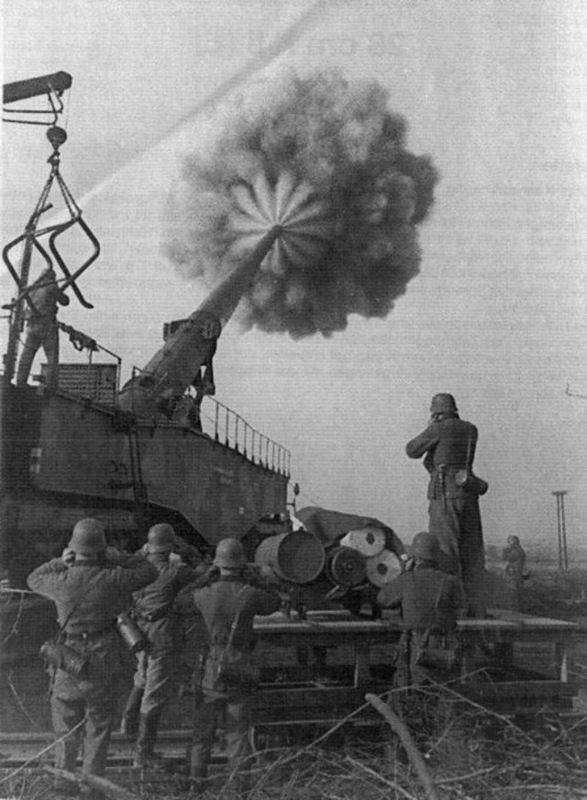
Only the "Gustav" was applied in the case. It is an instrument made 42 shots during the siege of Sevastopol in 1942. Its enormous destructive power shells (each of which had a mass of 4800 kg), enough to destroy the ammunition depot, which was protected by a 30-meter cliff. There were plans to use this instrument of rockets that could hit targets at a distance of 145 kilometers. Weapons expert Alexander Lüdecke called these instruments "technological masterpiece", but also said that it was "a waste of labor and materials».
Rat Bomb

After the capitulation of France, Winston Churchill promised to "set fire to Europe." After that, the British special agents have adopted a variety of disguised explosive devices, which surprised even James Bond. The bombs were disguised as soap, shoes, wine bottles, bags and even rats.
Yokosuka MXY7 Ohka
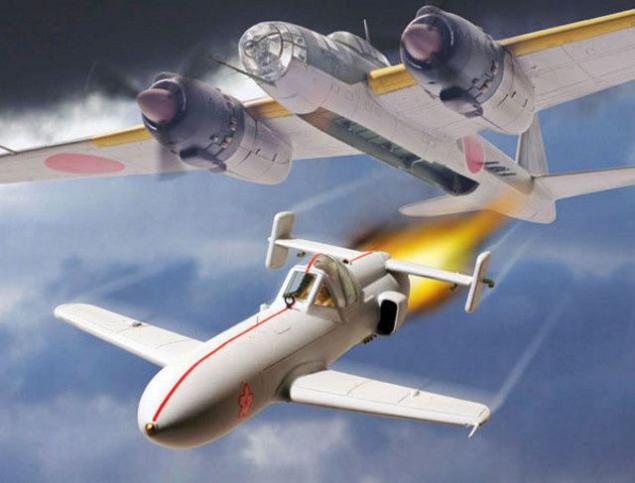
To increase the effectiveness of the kamikaze, the Japanese in 1944 released Ohka - flying bomb, controlled pilot bomber.
This jet, specially created for the kamikaze, was equipped with a 1, 2-ton warhead. These planes transported the bomber Mitsubishi G4M. When the target is within reach, Ohkaotdelyalsya from the bomber, the pilot flew up as close as possible to the goal, then run jet engines and with great speed crashed into a set goal. Anti-Hitler coalition troops quickly learned to neutralize the bombers before flying bombs were separated from them, which nullified their effectiveness. Still, one case of when Ohka sank a US destroyer.
Soviet anti-tank dogs
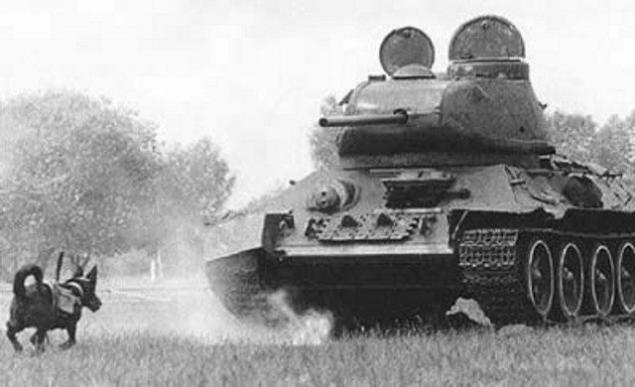
When our troops were in an extremely difficult situation on the Eastern Front had the desperate search for new means of warfare - including the use of so-called anti-dog. These dogs are specially trained to deliver the bomb to the desired goal, it mouth to activate and run back. Unfortunately, very rarely the dogs were able to correctly carry out the required tasks, so we had to use a more primitive strategy - simply blow up dogs.
These dogs bombers coached on what they can find food on the bottom of the tank. Therefore, they deliberately kept hungry, tied him to a 12-kilogram bombs and released to the appropriate target. They ran up to the tanks, trying to find food, unaware of their fate. When the dog ran under the bottom of the tank, the bomb was activated by a fixed arm that hits the tank. Thus, the dog effectively carry out its tasks, so some Germans have a habit to shoot at any dogs in sight. During the war, our army has been used about 40 thousand dogs to perform military tasks. According to estimates of undocumented thus destroyed about 300 enemy tanks.
"Toys" Hobart
In preparation for the Allied operations for landing troops in Normandy has been developed a lot of unusual techniques, some of which was named in honor of a military expert Percy Hobart. Here are some examples of such equipment
Sherman Crab
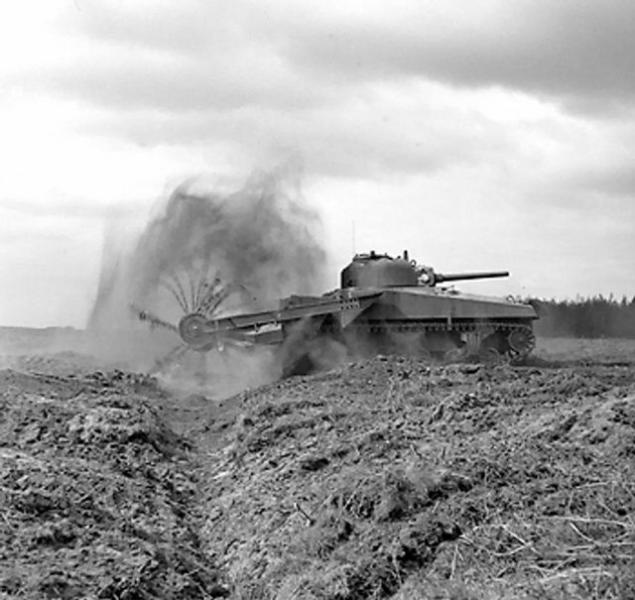
AVRE Bobbin
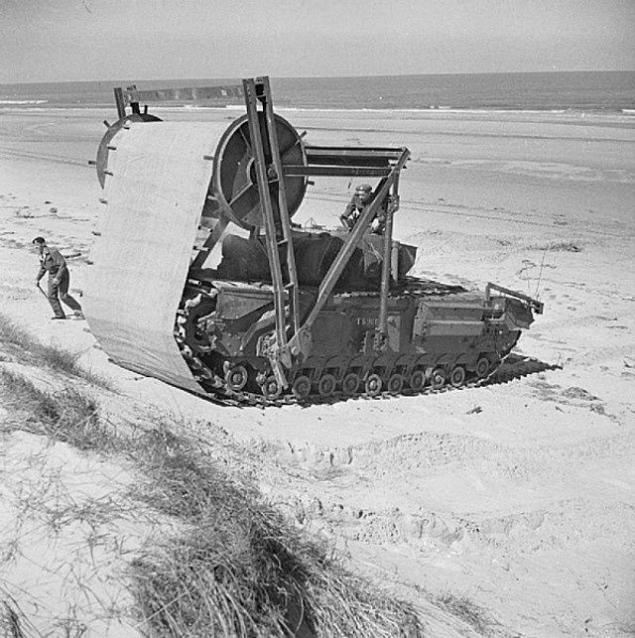
AVRE Bridgelayer
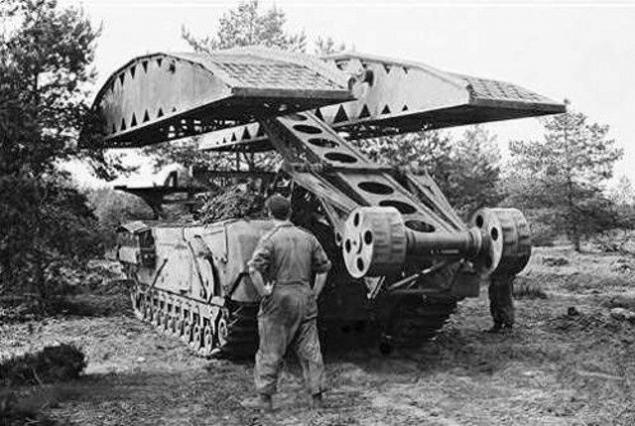
Radio-controlled bomb FritzXRuhustahlSD 1400
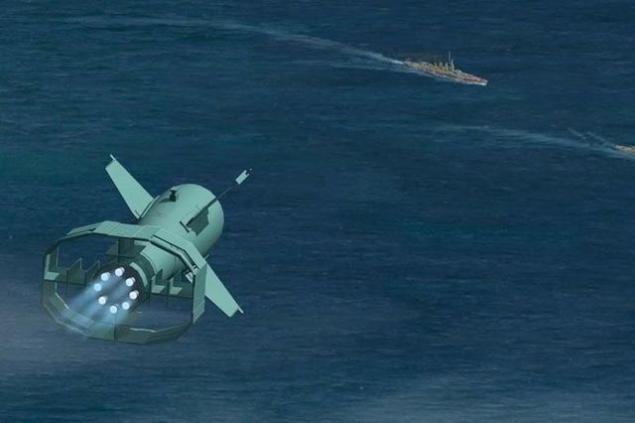
This bomb was intended for the destruction of heavily armored targets at sea, and was developed based on an armor-piercing bomb SD 1400 but have improved aerodynamics, four-1, 3-meter wings and tail. But the bomb was dropped directly over the target, which created an additional threat to the bomber.
It was a very formidable weapon against the anti-Hitler coalition. September 9, 1943 the Germans dropped a few bombs on the battleship of "Roma", sinking it with 1455 people on board. Also, using these bombs sank the British cruiser "Spartan", the destroyer "Janus", the light cruiser "Newfoundland" and damaged many other ships. Total were made about two thousand such bombs, but employed about 200. A big problem was that the bombs could only fall vertically, making it difficult bombers, who suffered heavy losses.
Guided aerial bomb HenschelHs 293

This bomb was one of the most efficient in the Second World War, using it sank and damaged a lot destroyers and merchant ships. After resetting the rocket booster clocked bomb within 10 seconds, then began planning phase towards the goal, using radio command control. At the tail of the bomb was set beacon to the gunner could monitor her location and mission, both day and night. It was first applied in August 1943, sinking the British sloop «Egret». Toward the end of the war, the troops have learned to intercept anti-Hitler coalition and its radio frequencies interfere with radio control, which greatly reduced the effectiveness of these bombs.
Non-rotating shells
This is one of those ideas that look good on paper, but in practice are terrible. Non-rotating shells - a British invention, launchers anti-aircraft installations, which fires projectiles that exploded in the air and released the parachutes and wires with small bombs at the ends. The idea was to create a small air minefield. The plane caught on the wire, attracted bombs and they exploded. The problem is that the wind could carry the trap to the right place (for example, back to the burst of the installation). But despite this, the weapons are widely used in the early days of the war.
Midget submarines

These tiny submarines for four people, invented by the Italians could swim a distance of up to 2 thousand kilometers, immersed to a depth of 100 meters and swim at speeds up to 6 knots. Displacement of these submarines was only 30 tons. They had only one hatch, which created major problems in emergency situations.
Self-propelled mine "Goliath»
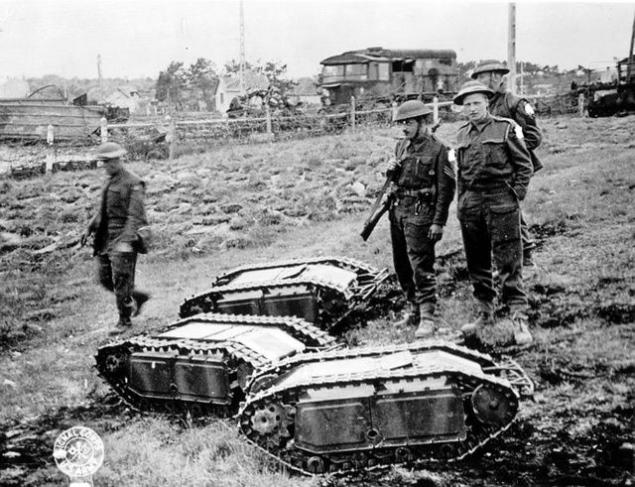
The first such devices were used by the Germans in 1942 to deliver a 75-kilogram bomb to the target (usually it was the tanks, dense clusters of infantry, bridges or buildings). Wedge wire-guided from a distance and explode when approaching the target. It is made of 4600 self-propelled mines, including an enlarged version, which could carry a 100-kilogram bombs. Unfortunately for the Germans, these devices were very slow, poorly managed and have low lifting capacity. But the idea is clearly ahead of its time. "Goliaths" - a sort of precursor of some modern robots, but just in time for the technology were not sufficiently developed.
Advance reservation that all the weapons listed below, was used during the war. Although there was plenty of high-tech (and sometimes quite strange) development, here we go just about something interesting weapon, which was actually used.
V-3

V-1, V-2 and V-3 (V-3 is also known as "Centipede" and "The English cannon") - a project of the Nazis under the name "Revenge Weapon". V-3 - an enormous cannon, built on a hill and is capable of being in France, to bombard London across the English Channel. The gun had a total length of 124 m, a gun barrel 32 consists of four long sections, 48 m; Each section had two located along the trunk at an angle to it bolt. During the trial in May 1944 showed a gun firing range of 88 kilometers, and during testing in July 1944 flight of the projectile was 93 kilometers.
It was built two guns V-3, and only one of them has been applied in practice. From 11 January to 22 February 1945 it produced about 183 shots. The aim was recently freed from Nazi Luxembourg. But the gun only to demonstrate their inefficiency. Objectives reached 143 shells, which, fortunately, was killed just 10 people and 35 were injured.
Super-heavy railway artillery "Dora" and "Gustav»

The Nazis was definitely a "quirk" about the big guns. These two guns caliber 807 mm were just gigantic. Indeed, it was the largest in the world gun. Each of them could only be transported in parts, then they should be collected and placed on pre-prepared platform - for all these procedures took about 4,000 people. The Nazis launched a full regiment of anti-aircraft guns for protection, and special forces protected them from the guerrillas.

Only the "Gustav" was applied in the case. It is an instrument made 42 shots during the siege of Sevastopol in 1942. Its enormous destructive power shells (each of which had a mass of 4800 kg), enough to destroy the ammunition depot, which was protected by a 30-meter cliff. There were plans to use this instrument of rockets that could hit targets at a distance of 145 kilometers. Weapons expert Alexander Lüdecke called these instruments "technological masterpiece", but also said that it was "a waste of labor and materials».
Rat Bomb

After the capitulation of France, Winston Churchill promised to "set fire to Europe." After that, the British special agents have adopted a variety of disguised explosive devices, which surprised even James Bond. The bombs were disguised as soap, shoes, wine bottles, bags and even rats.
Yokosuka MXY7 Ohka

To increase the effectiveness of the kamikaze, the Japanese in 1944 released Ohka - flying bomb, controlled pilot bomber.
This jet, specially created for the kamikaze, was equipped with a 1, 2-ton warhead. These planes transported the bomber Mitsubishi G4M. When the target is within reach, Ohkaotdelyalsya from the bomber, the pilot flew up as close as possible to the goal, then run jet engines and with great speed crashed into a set goal. Anti-Hitler coalition troops quickly learned to neutralize the bombers before flying bombs were separated from them, which nullified their effectiveness. Still, one case of when Ohka sank a US destroyer.
Soviet anti-tank dogs

When our troops were in an extremely difficult situation on the Eastern Front had the desperate search for new means of warfare - including the use of so-called anti-dog. These dogs are specially trained to deliver the bomb to the desired goal, it mouth to activate and run back. Unfortunately, very rarely the dogs were able to correctly carry out the required tasks, so we had to use a more primitive strategy - simply blow up dogs.
These dogs bombers coached on what they can find food on the bottom of the tank. Therefore, they deliberately kept hungry, tied him to a 12-kilogram bombs and released to the appropriate target. They ran up to the tanks, trying to find food, unaware of their fate. When the dog ran under the bottom of the tank, the bomb was activated by a fixed arm that hits the tank. Thus, the dog effectively carry out its tasks, so some Germans have a habit to shoot at any dogs in sight. During the war, our army has been used about 40 thousand dogs to perform military tasks. According to estimates of undocumented thus destroyed about 300 enemy tanks.
"Toys" Hobart
In preparation for the Allied operations for landing troops in Normandy has been developed a lot of unusual techniques, some of which was named in honor of a military expert Percy Hobart. Here are some examples of such equipment
Sherman Crab

AVRE Bobbin

AVRE Bridgelayer

Radio-controlled bomb FritzXRuhustahlSD 1400

This bomb was intended for the destruction of heavily armored targets at sea, and was developed based on an armor-piercing bomb SD 1400 but have improved aerodynamics, four-1, 3-meter wings and tail. But the bomb was dropped directly over the target, which created an additional threat to the bomber.
It was a very formidable weapon against the anti-Hitler coalition. September 9, 1943 the Germans dropped a few bombs on the battleship of "Roma", sinking it with 1455 people on board. Also, using these bombs sank the British cruiser "Spartan", the destroyer "Janus", the light cruiser "Newfoundland" and damaged many other ships. Total were made about two thousand such bombs, but employed about 200. A big problem was that the bombs could only fall vertically, making it difficult bombers, who suffered heavy losses.
Guided aerial bomb HenschelHs 293

This bomb was one of the most efficient in the Second World War, using it sank and damaged a lot destroyers and merchant ships. After resetting the rocket booster clocked bomb within 10 seconds, then began planning phase towards the goal, using radio command control. At the tail of the bomb was set beacon to the gunner could monitor her location and mission, both day and night. It was first applied in August 1943, sinking the British sloop «Egret». Toward the end of the war, the troops have learned to intercept anti-Hitler coalition and its radio frequencies interfere with radio control, which greatly reduced the effectiveness of these bombs.
Non-rotating shells
This is one of those ideas that look good on paper, but in practice are terrible. Non-rotating shells - a British invention, launchers anti-aircraft installations, which fires projectiles that exploded in the air and released the parachutes and wires with small bombs at the ends. The idea was to create a small air minefield. The plane caught on the wire, attracted bombs and they exploded. The problem is that the wind could carry the trap to the right place (for example, back to the burst of the installation). But despite this, the weapons are widely used in the early days of the war.
Midget submarines

These tiny submarines for four people, invented by the Italians could swim a distance of up to 2 thousand kilometers, immersed to a depth of 100 meters and swim at speeds up to 6 knots. Displacement of these submarines was only 30 tons. They had only one hatch, which created major problems in emergency situations.
Self-propelled mine "Goliath»

The first such devices were used by the Germans in 1942 to deliver a 75-kilogram bomb to the target (usually it was the tanks, dense clusters of infantry, bridges or buildings). Wedge wire-guided from a distance and explode when approaching the target. It is made of 4600 self-propelled mines, including an enlarged version, which could carry a 100-kilogram bombs. Unfortunately for the Germans, these devices were very slow, poorly managed and have low lifting capacity. But the idea is clearly ahead of its time. "Goliaths" - a sort of precursor of some modern robots, but just in time for the technology were not sufficiently developed.




